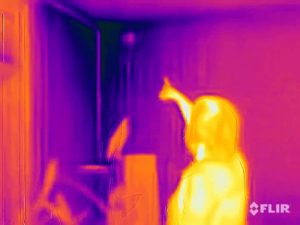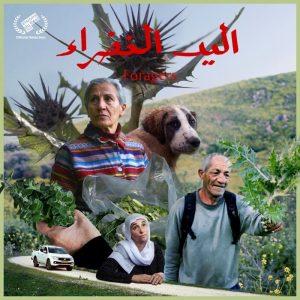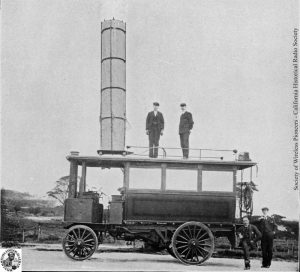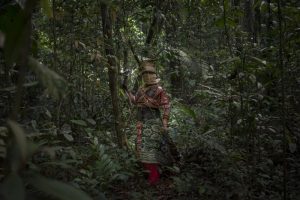Robert Ransick has completed a 6 month Residency at Eyebeam developing Casa Segura (Safe House).
The artwork combines a sheltered room on private land in the Sonoran desert in Southern Arizona with a bilingual web space that facilitates creative exchange and understanding.
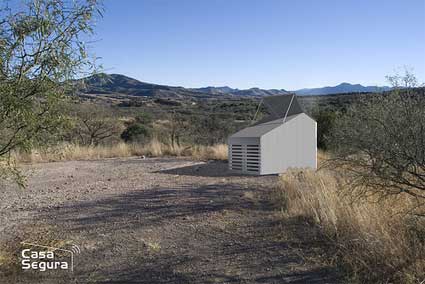
Casa Segura proposes private property owners on the border to create a life-saving beacon in the desert, a platform for engaging with the anonymous individuals crossing their land in search of a better life, and a non-aggressive means of protecting their homes.
Inside the small solar-powered structure migrants can find water, some food and a touch screen. Drawing upon traveler graffiti, pictograms, and the Mexican tradition of ex-voto painting, migrants are invited to use the interface and share something about themselves and their journey with the homeowner and anyone who’s interested. Migrants can either draw, write messages, or make a pictogram from ready-made graphical icons.
The images and messages are uploaded to the bilingual Casa Segura website. The website functions also as an access point for resources about immigration issues and the borders of the southwestern United States.
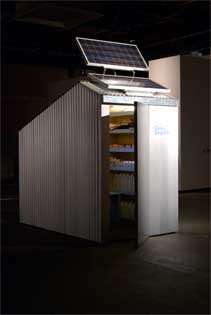
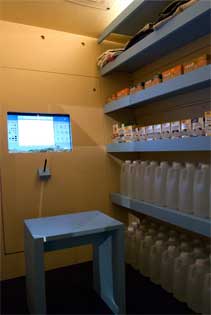
I asked Robert if he could give us more details about his project.
Casa Segura does not promise resolution to the complex set of issues revolving around the border, illegal immigration, and humanitarian efforts. Instead, it seeks to provide new opportunities for individual action, understanding, creative exchange and dialogue…
i am actually fascinated by these border issues. i also know that if i publish a story concerning the mexican/us border and if that story spreads outside of my usual readership, the blog post will get a lot of racist and unpleasant comments.
This is certainly something to be aware prior to publishing — there are many folks in the U.S. (Minutemen, civil militia groups, bigots etc) who have a very different, often fear-based, view of the border region and the individuals who are crossing. Unfortunately, theirs is a voice that is heard far too frequently in the media and I hope that this project can begin to open a space for other voices. There is a lot of grey, muddy space in between the extremes of the groups active on the border–this is the area i am interested in exploring with Casa Segura.
… but i suspect that at the eyebeam exhibition your work is meeting with approval. But do you expect that it will be the same once you’ve installed the casa segura in the desert where not only migrants will be happy to find it to get shelter and food, but people angry at border-crossing might want to vandalize it. Is it something you are prepared for?
People who encounter CS at Eyebeam seem to be very interested in the work and the issues it is in dialogue with. I think that people are excited by an artwork that not only embodies content/ideas/aesthetics, but that will be placed out in the world and may actually have some sort of tangible impact.
I am prepared to receive hate mail/calls and the likes (I have tried to make myself less accessible by registering my domains anonymously etc, but the web has a memory and if someone wants to find me, they will.) I am not fearful of such encounters and want to believe that there will be some opportunity in everything that happens with CS, even if some things that unfold are less pleasant than others. Maybe that is naive? Nah, love over fear and hate any day, right?
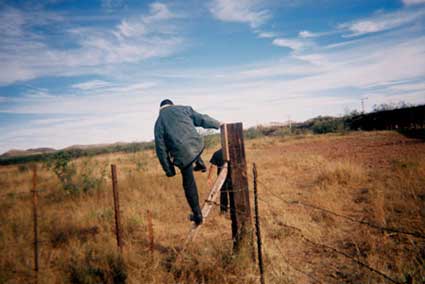 Image from the Border Film Project
Image from the Border Film Project
The CS structure will be located on private property and we do not plan to make the exact location public. That said, if someone finds the structure and wishes to damage it, that is certainly a possibility and one I have considered. If this does happen, we will do everything possible to make repairs and get everything up and running again.
I have given a great deal of thought to what would constitute a failure once it moves out west. What if no one finds CS? What if someone damages it etc? i should say that having people begin to think of border issues from the perspective of a border home owner and the questions/dilemmas they face, in tandem with what it might be like to be a migrant in this harsh landscape desperate for something as basic as water is extremely important to me. So, if no migrants happen upon the structure, that will only be a partial failure in my mind, as long as i am able to get the ideas into the public imagination.
I read that the project is inspired by the experiences lived by property owners living at the borders. Have you discussed with migrants about what the casa segura could mean for them? before embarking on the project but also now that it is on show at eyebeam?
Yes, my personal experiences (family on the border/partner of the last 15 years grew up there, etc) and that of the property owners and other friends have informed many aspects of this project. However, it is very important for me to not claim to be able to speak for a Mexican migrant making this journey. Even though i have done extensive research into what it might be like, i still have no real first-hand knowledge/understanding of what drives someone to make this choice. Again, this is part of the interest in providing an opportunity for these individuals to speak/leave a trace behind via the interface–that might begin to provide insights for the rest of us who watch from a distance.
I have spoken to a small number of illegal immigrants (in the US and Mexico) about the project and they were very interested and supportive. No one knows how they would react upon finding the structure, because the entire idea is so foreign/unusual. Also, many migrants never find themselves in such a desperate state that they would be willing to break into a house for food/water/clothes, so it is hard to know/speculate what would happen if you were in this position and found CS. Everyone i spoke to suspects that it would be an overwhelmingly positive experience, but we just don’t know for certain.
No one has come forward to contact me from the Eyebeam show and specified they were illegal. However, some of the pictograms being created at eyebeam and online indicate that there might be some folks visiting who either are illegal or have connections to migrants.
Luis Alberto Urrea, who is the extraordinary author of several books (i highly recommend The Devil’s Highway: A True Story) and other articles that i read while doing my research is planning to blog about the project too–i am very interested in seeing what the results will be, as his audience is very attuned to the topic from first hand accounts to activists etc.
There are other activist and/or border projects, is there any in particular which you find interesting and worth mentioning?
First and foremost, the many excellent art projects from inSite 05. Low drone is terrific.
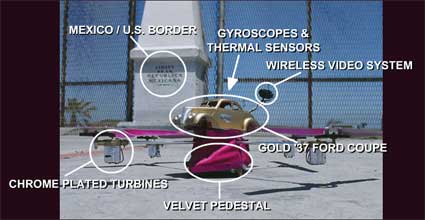 Lowdrone
Lowdrone
I am also a fan of the CECUT Project by Krzysztof Wodiczko.
My collaborators, Alberto Morackis and Guadalupe Serrano of Yonke Arte Público who have done many projects in Nogales on the border wall and more.
The Border Action Network is an incredible advocacy group.
“Border Action Network formed in 1999 and works with immigrant and border communities in southern Arizona to ensure that our rights are respected, our human dignity upheld and that our communities are healthy places to live. We are a membership-based organization that combines grassroots community organizing, leadership development, litigation and policy advocacy.”
And the following for direct outreach to migrants: Humane Borders and No More Deaths.
There are more (on the CS website), but those are most of my favorites.
Now a very down-to-earth question. The building instructions are available online for other property owner to build their own Casa Segura. Have you heard of anyone who decided to build one? It looks a bit costly, which kind of advice would you give to someone who would want to build a Casa Segura but at lower costs? Do you think that the CS would still be meaningful without the computing technology?
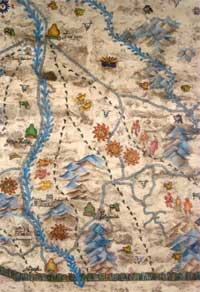 I am just beginning to do outreach via the press and internet, so at this point i am not sure that word has spread widely enough to have inspired anyone to build their own CS. I do hope that as people find out about the project that they will be interested in modifying our ideas for their own situation.
I am just beginning to do outreach via the press and internet, so at this point i am not sure that word has spread widely enough to have inspired anyone to build their own CS. I do hope that as people find out about the project that they will be interested in modifying our ideas for their own situation.
This project is about presenting alternate choices for individuals who have migrants crossing their land and understanding the complex situation from a humanist point of view and not so much about cloning Casa Segura along the border. I definitely want the ideas to be “do it yourself/open source” and I would be thrilled if people were inspired to simply place weather proof bins with water and food on their property for migrants to access. One could encourage communication by placing a sketchbook in the bin with an invitation to the migrants to leave a message.
I have chosen to use computing technology because it is a medium that i work within and i believe that it provides many opportunities that certain analogue approaches do not. That does not mean that I feel that having a computer in a shed on your property is the only means of engaging in the kinds of exchanges i hope to foster with CS.
The computing technology presents an opportunity from a particular point of view, but the goals here are quite simple: saving lives and communication. That can happen in many different ways and I encourage people to be creative and do what makes sense to them and their situation.
What is the most surprising thing you’ve learnt about desert survival while working on this project?
The most surprising thing i found during my research was in relation to witnessing firsthand the many people who are crossing each day into Arizona. I attended a conference organized by Humane Borders last March and we traveled south to Altar, Mexico, which is the single largest staging ground for migrants preparing to make the journey through the desert. The town is located approximately 50 miles south of the border-town Sasabe. While on the road south from Sasabe, every few minutes a van passes full of people who are making the trek to the border. Each van has been retrofitted and holds anywhere from 25-35 (packed-in) people. We were told that during March, which is already getting late in the season, somewhere between 2500-3500 people are making their way north each day. When you see the faces of these people, who are typically only represented through some statistic on a page, and watch them being herded like cattle from vans to pickup trucks and then plunked into the desert to walk for days with inappropriate supplies, you cannot help but feel for them. You know that something has to change and it is not going to be guns or walls or hate that transforms this horrible situation.
The project also involves pictograms which “represent significant individuals, saints and symbols of Mexican history and popular culture.” What motivated your choice to use these pictograms? I’ve never been to Mexico (sigh!) –so please excuse my silly question– but are these pictograms still playing a significant role in the cultural life of Mexicans?
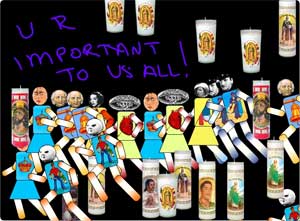 The icons were created in collaboration with with Alberto Morackis and Guadalupe Serrano of Yonke Arte Público, Nogales, Mexico. One of my concerns was that for someone arriving to the CS structure, the glowing screen in the back of the space may prove to be surprising, intimidating or scary. I wanted to create something that might allow an individual to transcend those immediate anxieties and feel comfortable engaging. I looked at traveler graffiti and then ex-voto and retablo practices in order to find some visual/textual vernacular that might cut across socio-economic and educational backgrounds. I expressed all of my ideas and interests to Alberto and Guadelupe, who began thinking along these lines in relation to cultural relevance and familiarity for any Mexican citizen. They chose to create the characters using the Lotería cards as the bodies, because “everyone in Mexico knows Lotería” and then the individuals were chosen based on Mexican cultural and political history. They chose individuals who a migrant may connect with and who might possibly inspire strength for continuing their journey. I love the icons visually and conceptually–they embody history, popular cultural, playfulness and intelligence.
The icons were created in collaboration with with Alberto Morackis and Guadalupe Serrano of Yonke Arte Público, Nogales, Mexico. One of my concerns was that for someone arriving to the CS structure, the glowing screen in the back of the space may prove to be surprising, intimidating or scary. I wanted to create something that might allow an individual to transcend those immediate anxieties and feel comfortable engaging. I looked at traveler graffiti and then ex-voto and retablo practices in order to find some visual/textual vernacular that might cut across socio-economic and educational backgrounds. I expressed all of my ideas and interests to Alberto and Guadelupe, who began thinking along these lines in relation to cultural relevance and familiarity for any Mexican citizen. They chose to create the characters using the Lotería cards as the bodies, because “everyone in Mexico knows Lotería” and then the individuals were chosen based on Mexican cultural and political history. They chose individuals who a migrant may connect with and who might possibly inspire strength for continuing their journey. I love the icons visually and conceptually–they embody history, popular cultural, playfulness and intelligence.
In addition, Alberto and Guadelupe selected a number of saints and folk heroes whom people may regularly give thanks to or pray to by lighting a candle with their representation on it for the interface.
Thanks a lot Robert!
Casa Segura is exhibited at Eyebeam in New York, until Nov. 10th, 2007.
Image on top eyebeam. All other pictures of Casa Segura courtesy of the artist.
Related entries: The real super heroes, Web users to patrol us borders, Trainers for border crossers, Dentists on the border Mexico / U.S.A.

